Phylum Chordata | Scientific name Craniata Higher classification Chordate | |
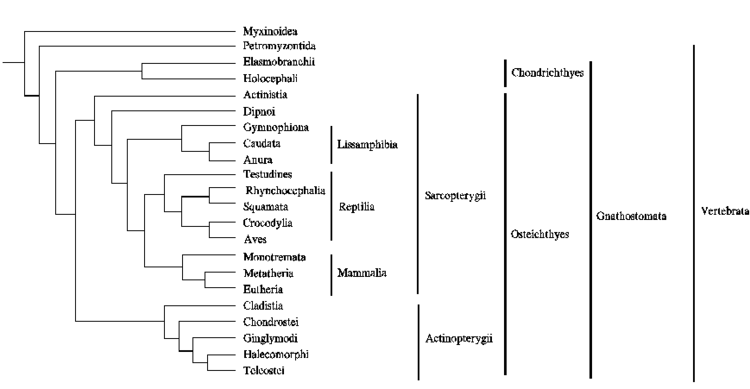 | ||
Clade CraniataLankester, 1877 Lower classifications Vertebrate, Amphibians, Hagfish, Shark, Frog | ||
Cladogram 9 craniates
A craniate is a member of Craniata (sometimes Craniota), a proposed clade of chordate animals that contains the Myxini (hagfish), Petromyzontida (including lampreys), and the much more numerous Gnathostomata (jawed vertebrates) as living representatives. As the name suggests, craniates are animals with a (hard bone or cartilage) skull in phylum Chordata.
Contents
- Cladogram 9 craniates
- Craniate anatomical features 2
- Characteristics
- Systematics and taxonomy
- Validity
- Classification
- References

Craniate anatomical features 2
Characteristics

In the simplest sense, craniates are chordates with heads, thus excluding members of the chordate subphyla Tunicata (tunicates) and Cephalochordata (lancelets), but including Myxini, which have cartilaginous skulls and tooth-like structures composed of keratin. Craniata also includes all lampreys and armored jawless fishes, armoured fish, sharks, skates, and rays, and teleostomians: spiny sharks, bony fish, lissamphibians, temnospondyls and protoreptiles, sauropsids and mammals. The craniate head consists of a brain, sense organs, including eyes, and a skull.
In addition to distinct crania (sing. cranium), craniates possess many derived characteristics, which have allowed for more complexity to follow. Molecular-genetic analysis of craniates reveals that, compared to less complex animals, they developed duplicate sets of many gene families that are involved in cell signaling, transcription, and morphogenesis (see homeobox).
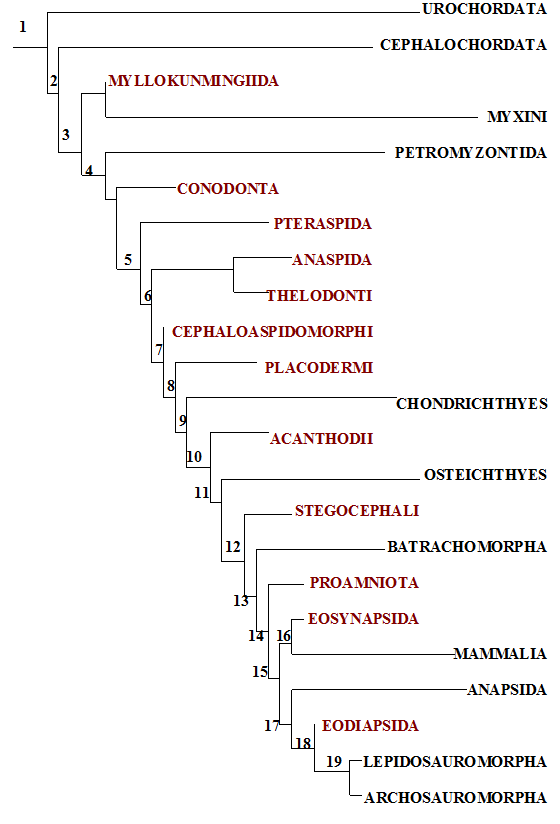
In general, craniates are much more active than tunicates and lancelets and, as a result, have greater metabolic demands, as well as several anatomical adaptations. Aquatic craniates have gill slits, which are connected to muscles and nerves that pump water through the slits, engaging in both feeding and gas exchange (as opposed to lancelets, whose pharyngeal slits are used only for suspension feeding). Muscles line the alimentary canal, moving food through the canal, allowing higher craniates such as mammals to develop more complex digestive systems for optimal food processing. Craniates have cardiovascular systems that include a heart with two or more chambers, red blood cells, and oxygen transporting hemoglobin, as well as kidneys.
Systematics and taxonomy
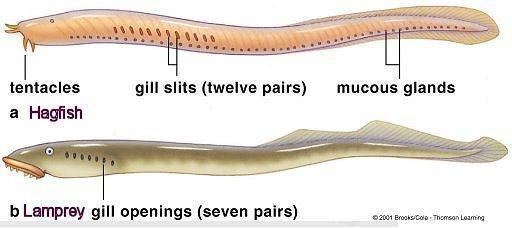
Linnaeus (1758) used the terms 'Craniata' and 'Vertebrata' interchangeably to include lampreys, jawed fishes, and terrestrial vertebrates (tetrapods). Hagfishes were classified as Vermes, possibly representing a transitional form between 'worms' and fishes. Dumeril (1806) grouped hagfishes and lampreys in the taxon 'Cyclostomi', characterized by horny teeth borne on a tongue-like apparatus, a large notochord as adults, and pouch-shaped gills (Marspibranchii). Cyclostomes were regarded as either degenerate cartilaginous fishes or primitive vertebrates. Cope (1889) coined the name 'Agnatha' (jawless) for a group that included the cyclostomes and a number of fossil groups in which jaws could not be observed. Vertebrates were subsequently divided into two major sister-groups; Agnatha and Gnathostomata (jawed vertebrates). Stensiö (1927) suggested that the two groups of living agnathans (i.e., cyclostomes) arose independently from different groups of fossil agnathans. Løvtrup (1977) argued that lampreys are more closely related to gnathostomes based on a number of uniquely derived characters, including: arcualia (serially arranged paired cartilages above the notochord), extrinsic eyeball muscles, radial muscles in the fins, a closely set atrium and ventricle of the heart, nervous regulation of the heart (by the vagus nerve), a typhlosole (spirally coiled valve of the intestinal wall), true lymphocytes, a differentiated anterior lobe of the pituitary gland (adenohypophysis), three inner ear maculae (patches of acceleration sensitive 'hair cells' used in balance) organized into two or three vertical semicircular canals, neuromast organs (composed of vibration sensitive hair cells) in the laterosensory canals, an electroreceptive lateral line (with voltage sensitive hair cells) and electrosensory lateral line nerves, and a cerebellum (i.e., the multi-layered roof of the hindbrain with unique structure [characteristic neural architecture including direct inputs from the lateral line and large output Purkinje cells] and function [integrating sensory perception and coordinating motor control]). In other words, the 'cyclostome' characteristics (e.g., horny teeth, "tongue", gill pouches) are either instances of convergent evolution for feeding and gill ventilation in animals with an eel-like body shape, or represent primitive craniate characteristics subsequently lost or modified in gnathostomes. Janvier (1978) proposed to use the names 'Vertebrata' and 'Craniata' as two distinct and nested taxa.
Validity
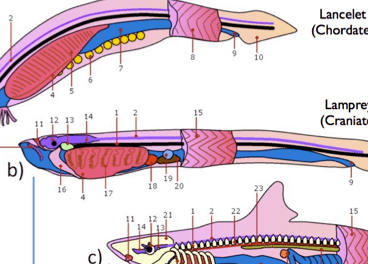
The validity of the taxon "Craniata" was recently examined by Delarbre et al. (2002) using mtDNA sequence data, concluding that Myxini is more closely related to Hyperoartia than to Gnathostomata - i.e., that modern jawless fishes form a clade called Cyclostomata. The argument is that, if Cyclostomata is indeed monophyletic, Vertebrata would return to its old content (Gnathostomata + Cyclostomata) and the name Craniata, being superfluous, would become a junior synonym.
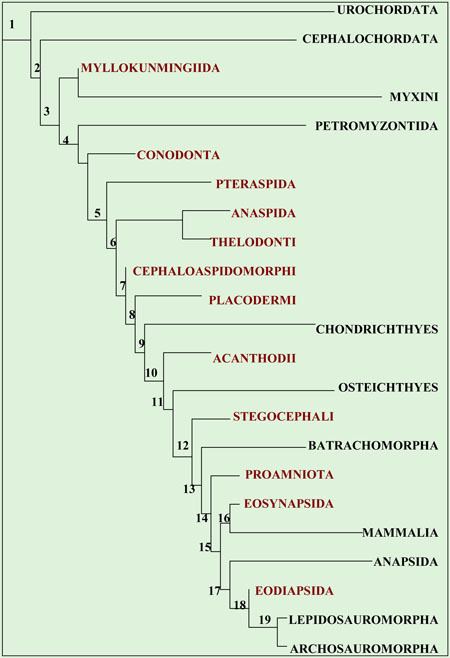
The new evidence removes support for the hypothesis for the evolutionary sequence by which (from among tunicate-like chordates) first the hard cranium arose as it is exhibited by the hagfish, then the backbone as exhibited by the lampreys, and then finally the hinged jaw that is now ubiquitous. In 2010, Philippe Janvier stated:
Although I was among the early supporters of vertebrate paraphyly, I am impressed by the evidence provided by Heimberg et al. and prepared to admit that cyclostomes are, in fact, monophyletic. The consequence is that they may tell us little, if anything, about the dawn of vertebrate evolution, except that the intuitions of 19th century zoologists were correct in assuming that these odd vertebrates (notably, hagfishes) are strongly degenerate and have lost many characters over time.
Classification
Cladogram of the Chordate phylum. Lines show probable evolutionary relationships, including extinct taxa, which are denoted with a dagger, †. Some are invertebrates. The positions (relationships) of the Lancelet, Tunicate, and Craniata clades are as reported in the scientific journal Nature. Note that this cladogram, in showing the extant cyclostomes (hagfish and lamprey) as paraphyletic, is contradicted by nearly all recent molecular data, which support the monophyly of the extant cyclostomes (see Ota and Kurakani 2007 and references therein for a review of evidence).
